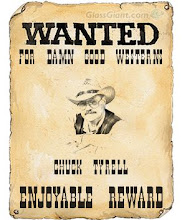Louis L'Amour and Zane Grey and Jack London either lived the West or listened to people who did. I'm a generation behind L'Amour, if you figure a generation to be thirty years. Still, I feel I knew many of the people who "won" the West. That's why I write about the West, and I'd like to let you all know about the sons and daughters of the pioneers that I knew. Let me tell you about Aunt Hat.
Aunt Hat's Chili
Aunt Hat and Uncle Jess lived on the bluff above Show Low Creek. Their house was small, stucco on frame, with one of those wavy galvanized tin roofs. But you'd be surprised how many people it could hold whenever Aunt Hat made chili.
There was always a string of chili peppers hanging in the kitchen. And whenever she'd run low, she'd send Earl over to Orlando Baca's place in Concho to buy another string.
Aunt Hat kept a stock pot on the back of her old wood-burning stove. She and Grandma Em were the only women I knew who still cooked with wood. Bones and meat trimmings went into that stock pot every day. And every morning, after a couple of chunks of juniper went into the stove to liven up the coals left over from the night before, Aunt Hat would fish the bones out of the stock pot, scrape the marrow out, pull off any strings of meat, and toss those bones in the dog pan. She'd skim the grease off the top of the stock pot and put it in a Mason jar. Never did figure out what she did with that grease, but every once in a while, that Mason jar would be empty.
Come time to make chili, Aunt Hat ladled a couple of quarts of stock into a big cast-iron dutch oven. She'd have a pile of meat trimmings, a couple of pounds at least, which would go into the dutch oven to boil with the stock.
"Go get the onions," she'd say to me. "Even a knee-high brat like you can cut onions." So I got to peel and chop a half dozen big ol' onions to put in that pot with the meat trimmings. Talk about tears.
Three or four of those hot chili peppers came off the string, and Aunt Hat ground them up on an old Anasazi metate Uncle Jess had found not far from the house. Grand Uncle Ned found the remains of a rudimentary cliff dwelling in that bluff above the creek. Carbon dating put a wooden beam from the dwelling at ca. 1200. The metate may have been from the same time. It sure made powder out of those chili peppers, seeds and all.
Some folks put the chili powder right in the kettle. Not Aunt Hat. She always roasted the chili powder in a frying pan and then mixed it with lard to make a kind of chili roux. "Rounds it off just a little," she'd say. Into the dutch oven it went, along with two or three grated carrots, a couple of tomatoes, and some roasted, skinned, and chopped California chiles -- mild, but flavorful.
The dutch oven sat and simmered on Aunt Hat's wood stove until the concoction was reduced to dark, reddish-brown liquor, thick with gelatin from the meat scraps. She'd soaked a quart of pinto beans overnight, and they were now plump and swollen. Aunt Hat dumped the beans into the dutch oven, water and all, and set it on the back of the stove where it would stew until the next evening.
Aunt Hat never tasted her chili until the morning of the second day. When she lifted the cast-iron lid of that deep dutch oven, steam rose and the unmistakable fragrance of chile con carne y frijoles filled the kitchen. She'd taste the chili and start adjusting things. Some cilantro. Black pepper. A little vinegar. A bay leaf or two. A touch of honey.
Satisfied, she hefted the big lid back on the oven and let it sit. There on the back of the stove, it wasn't hot enough to boil, but it was too hot to spoil. And all those ingredients just sat there and melded.
The men and boys would start coming just after noon. They'd put two loads of hay in the big barn just over the bluff, and they're ready for dinner. No one in Show Low, Arizona, eats lunch. It's breakfast, dinner, and supper, and the biggest meal of all is dinner.
Aunt Hat's ready. The chili is steaming in a huge bowl in the center of a table that seats twelve. She's cut inch and a half thick slices of the whole-wheat bread she baked on Thursday, and piled them on two platters, one at each end of the table. Pats of golden butter the size of an upside-down coffee cup stand ready for the bread. The deep color of the butter tells you one of Uncle Jess's cows is a Jersey. The apple pie is still in the pantry. After the bread and chili, it will be served with fresh cream and coffee.
In my end of Arizona, bread and chili go together naturally. You butter a slice of that homemade bread. Put in on your plate. And smother it with chili. My mouth waters just writing about it.
Aunt Hat's gone. So's Uncle Jess. Even Earl rides Old Blue in the great beyond. He never did get a driver's licence. Us kids that crowded Aunt Hat's on chili days grew up and moved away. Now we've got kids and grandkids of our own. And while our chili don't hold a candle to Aunt Hat's, we still try.
# # #
(c) Charles T. Whipple
SHARPE'S STORM - Book review
7 hours ago



